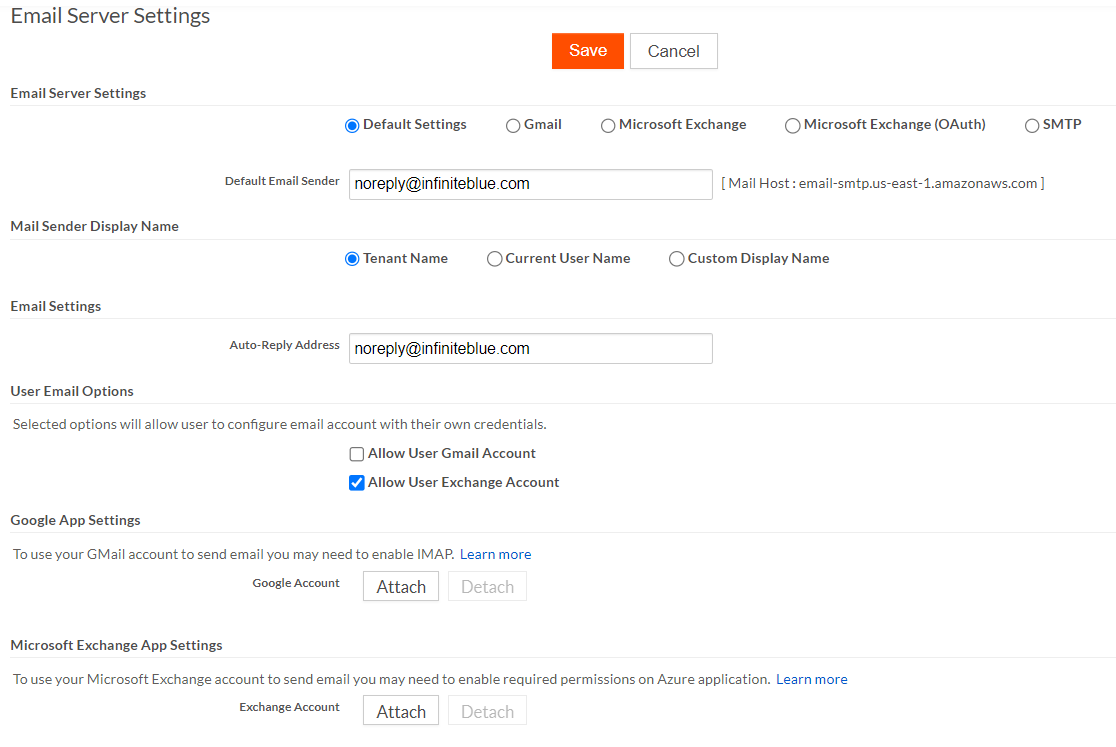Account administration and security settings
You can specify the following account administration and security settings for your tenant:
- Multi-Currency Support:
This page enables you to manage currency names and codes. For information about multi-currency support, see Multi-currency support.
- Email Server
Settings:
This page enables you to configure the email account that will send administrative messages from Platform. You can configure Platform to use one of the following types of accounts:
- Default— By default, Default Settings is selected, which uses the email server settings as set in the Control Panel along with the Default Email Sender.
- Gmail — See Integrating with Google applications for details.
- Microsoft Exchange — To
configure an Exchange account:
- Select Microsoft Exchange.
- Enter the Exchange email address in the User Name field.
- Enter the Exchange password in the Password field.
- Enter an auto-reply email address in the Auto-Reply Address field.
- Before you can save the settings, you must test them by sending a test email message to a different email address. Enter the email address to which you want to send the test message in the Email Address field and click Test Settings.
- A pop-up dialog opens. After sending the message,Platformdisplays a message stating that the message was sent. Verify that the email was received and check Message Was Received in Mailbox to enable the Save option. If the email was not received, reconfigure your email server settings and try again.
- Click Save.
- Microsoft Exchange (OAuth) — See Enabling Microsoft Exchange Integration for details.
- SMTP — To configure an SMTP
account:
- Select SMTP.
- Edit the following email server settings: Host Name, Port
Number, Encryption (select
None if your email server is not enabled
for SSL & TLS encryption), User Name
(Email ID), Password (Email password), and a
default Auto-Reply Address.
This email address is used for all administrative email communication in your tenant.
- Test your email server settings by specifying a sample email
address and then clicking Test Settings to
see if a sample email message is received at the specified email address.
A pop-up dialog opens. After sending the message,Platformdisplays a message stating that the message was sent. Verify that the email was received and check Message Was Received in Mailbox to enable the Save option. If the email was not received, reconfigure your email server settings and try again.
The Default Email Sender is used as the "Reply To" address whenever Platform sends an email that was not invoked by a specific user's email address.
- Click Save.
- Mail Sender Display Name — User can provide default display name value in the text box. Select any of the below options to set the mail sender display name.
Tenant Name : By default, Tenant Name is selected, which uses the tenant's (customer) name as the mail sender display name.
Current User Name: Select this to have the current user's name to be set as the mail sender display name.
Note: Current User name setting is not applicable for background jobs.Custom Display Name: Select this to use a custom mail sender display name. If selected, the default value is set. When no value is entered, the tenant's (customer) name is considered as the default value.
Note:- The Mail Sender Display Name is currently applicable for Default and SMTP configurations only. This property is overridden by the server for Gmail and Microsoft Exchange server.
If Email Server Settings are set to Default, yet Gmail or Microsoft Exchange is configured at the instance level, then the Mail Sender Display Name cannot be configured.
- If the Display Name is not set at the TENANT level, the Customer Name is used as Mail Sender Display Name.
- Ensure that the shared property
EmailSettingsOverrideAtCustomeris set totrue, which enables you to set up a custom email server for your tenant.

To allow your users to communicate using their email addresses, one or more of the following check boxes must be selected. Gmail and Exchange are selected by default.
- Allow User Gmail Account
- Allow User Exchange Account
- Allow User SMTP Account
For PlatformPrivate Cloud customers, email server settings are updated in the Shared Properties.
- Google Apps Settings:
Specifies Google email account credentials to access Gmail, Google Calendar and Google Spreadsheets seamlessly withPlatformapps.
- Microsoft Exchange App Settings:
Attach/Detach the Microsoft Exchange account. You may need to enable required permissions on Azure application to send any emails. See Enabling Microsoft Exchange Integration for more information.
- Authentication:
This page enables you to configure your tenant to accept and perform external calls requested by an authenticated user. For information about user authentication, see User authentication.
- Whitelist of IP Addresses:
This page enables you to apply an additional security measure. You can specify whitelist of IP addresses to be checked when user logs in. For information on security and access control, see Security and access control.

